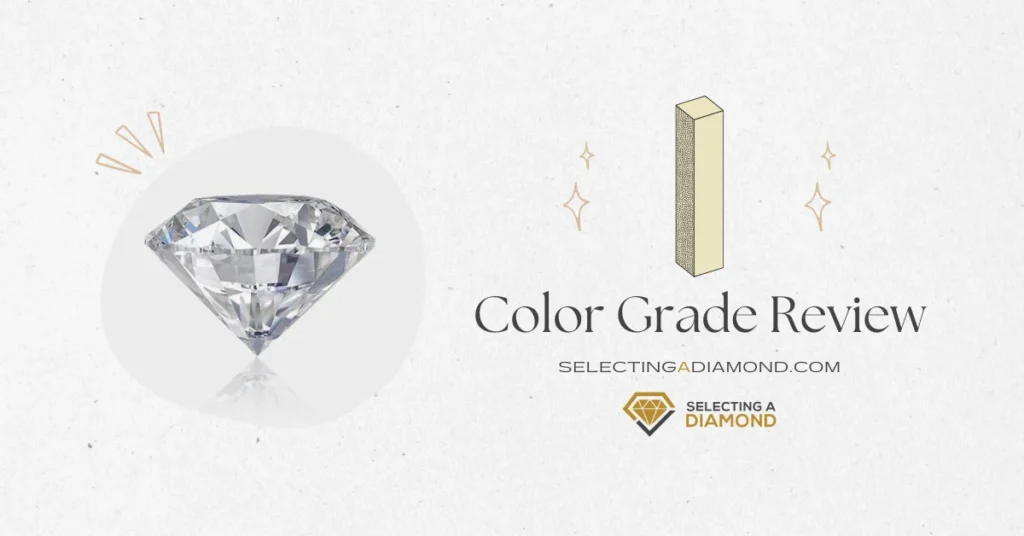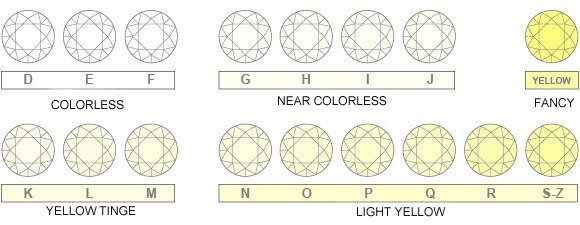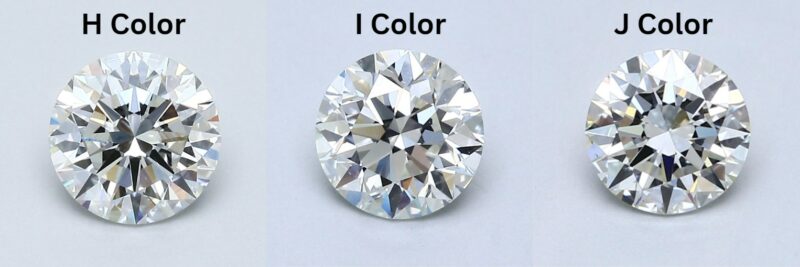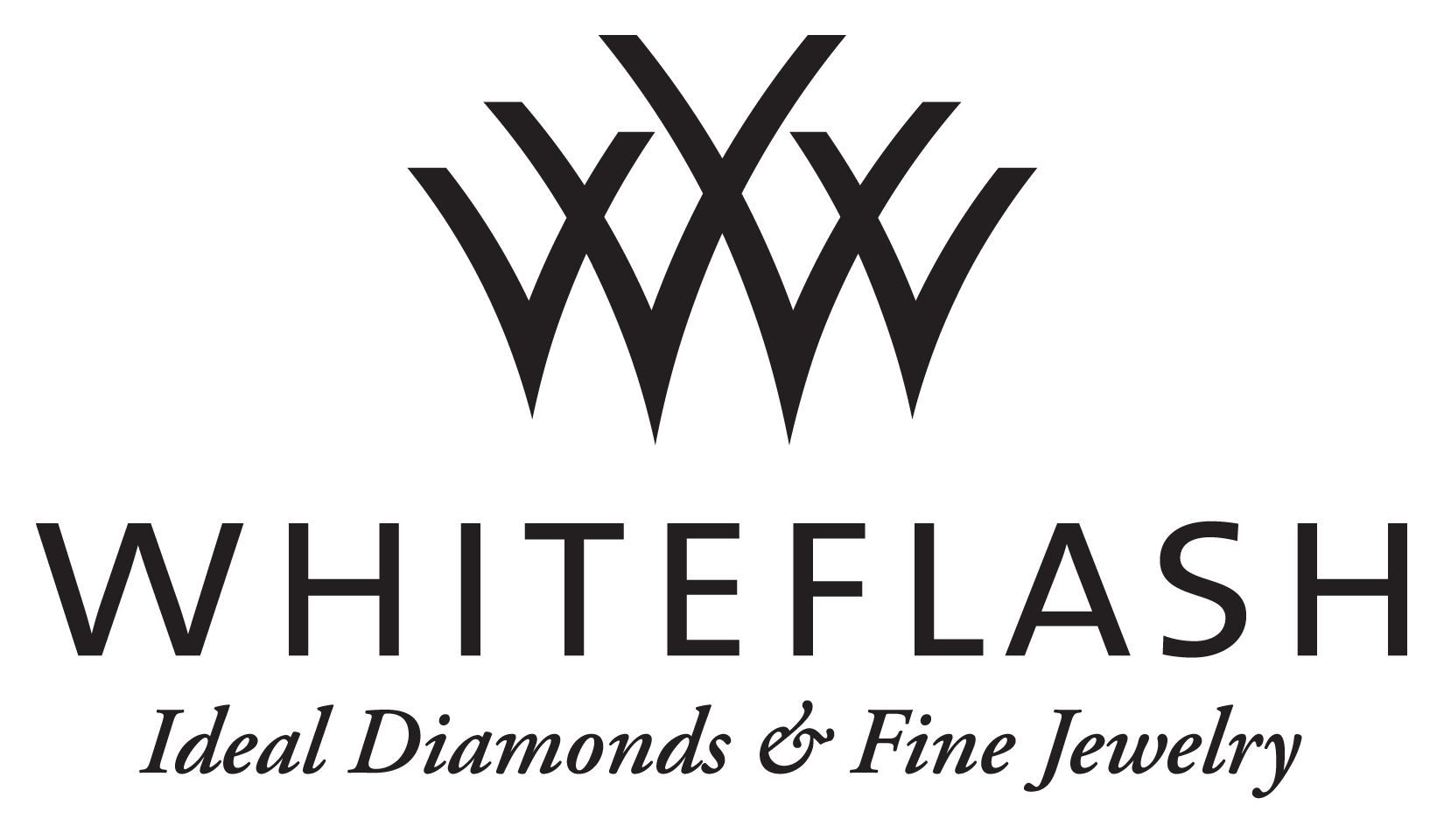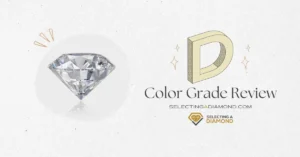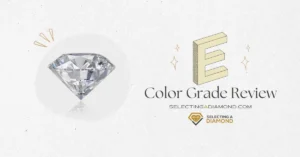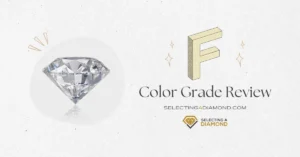They are less popular than G or H color diamonds, and completely out of radar for people seeking high color grades like D or E, but from experts point of view, are I color diamonds worth the money?
Or if we go crazy, can we ask: When I color diamonds are good choices?
In this post, we will go into details covering all you need to know about I color diamonds, how “yellow” they look, their price range, when they can be good choices, and from where you can get them.
We will also be examining how they do they look in comparison to other diamond colors, like the H color grade mainly since it’s the neighbor color.
To start, we think it would be useful to kick off the discussion by seeing an actual I color diamond, under magnificent imaging technology:
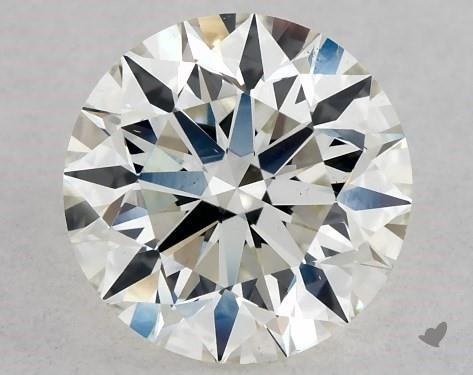
The angle of this image might give a false negative about how much color a diamond has, so it’s better to check it here on James Allen under 360 HD videos.
What is the I Color Grade?
The I color grade is part of the near colorless group, and this group is known to offer great value for money compared to overpriced colorless range (D-F), but as they say “not all your fingers are equal”, so there is a slight difference between G & H let’s say, and more than “slight” between G & I or J.
It’s crucial to distinguish between what we can see and what a GIA specialist with tens of years of expertise and cutting-edge equipment can see when studying diamond colors!
Blue Nile on their education page defines the I color grade as:
Still a great value, the slight yellow tint of I color diamonds are only detected when compared side-by-side with diamonds of H grades or higher. This color grade also pairs well with yellow gold. Fifteen percent of customers choose an I color diamond
James Allen, on the other hand says:
These diamonds have slight color, which tends to be more visible in diamonds over 1 carat.
- Compared side by side by a higher color grade (like the H or G color grade)
- Diamond is relatively large, i.e. more than 1 carat
But does that mean if you just see a small loose diamond in regular lighting conditions, will you be able to detect the yellow tint? Probably not.
We’re not saying you should get it without digging a bit further, what you should do is to learn to which extent it affects your ring appearance, when you should stay away from I color grade, and when you better get a diamond with I color grade since it doesn’t matter at that point.
Reminding ourselves here, you don’t need to go extremely high with color grades like E or F color diamonds to guarantee a flawless diamond, this can be guaranteed if you learn how to save yourself half a grand or more and get a G color grade for example.
Where I Color Grade Stands in Diamonds Color Chart?
I color sets near the middle of the near colorless range (G,H,I, and J), more towards the end of it, compared to its adjacent grade H, which is closer to the colorless end.
For a visual explanation, here is a representation of GIA color grading chart, where it shows the I coming 3rd in the near colorless group (and 6th from the purist color: The D color grade):
We suggest you also go over our diamond color guide to better understand how these grades are sorted & used, but for the time being, we believe it’s enough to learn that not ALL near colorless diamonds are the same.
Meaning, the G & H are more into the colorless group, while I & J goes the other way and closer to the yellow tinge group as explained in the chart above.
In our H color grade review, we learned why it’s a great starting point in diamond color for anyone, here with the I, we need to take it with a grain of salt.
Keep in mind that the color difference between adjacent colors are very minimal, and you (as a non-gemologist or diamond expert) will not be able to detect any difference unless diamonds are at least 2 grades apart.
I & Neighboring Colors: H vs I vs J Grade Difference
The last statement above here isn’t our own opinion, because James Allen confirms that as well, they clearly say that the visual difference between each color grade and the next one is very hard to detect.
Generally, when comparing color between two diamonds, the diamonds need to be at least two color grades apart to even begin to see a difference
So, for our color grade here, the I, how hard is it to tell any difference between it and H (being higher 1 level), and J (1 level down)?
In short: pretty hard, as a gemologist or experienced jeweler only will be able to tell the difference only under ideal conditions.
As mentioned above, the I grade is closer to the yellowish part of the near colorless group, while you might not be able to tell a difference between it and an H color, you will probably be able to do so when inspecting it with a G color.
Do we recommend it? Let’s see once we see a visual comparison between the 3 colors.
Visual Comparison
Diamonds colors when set on rings look different from inspecting them as loose stones.
In our opinion, not all online images reflect the real color of a diamond, specially when images are static, that’s why we always recommend James Allen for their top of the line imaging technology.
In terms of imaging technology, we’re big fans of Whiteflash as they offer superb diamond imaging quality, next comes Blue Nile (only for diamonds that have real images).
Bear in mind the diamond shape here, since we’re going a bit far from the colorless group, the difference in color appearance starts to be more noticeable depending on diamond shape.
Since round shape is the most popular shape, we will consider it our reference here to clarify the color difference in H vs I vs J grades.
We will fix the other Cs (cut, clarity, carat) to have a fair comparison, here are 3 images for the I grade and its adjacent colors as well, taken from Blue Nile:
As mentioned, static images (specially for round shape since it reflects light pretty well, making it very hard to detect color when viewing the top) don’t reflect the real appearance, that’s why we encourage you to check these diamonds in more details and 360 degrees, here is the H color, this is the I grade diamond, and this is the J color diamond.
That’s why they said diamonds need to be at least 2 grades apart to start seeing a difference.
Feel free to check more examples on James Allen if you want even higher quality images.
The price difference between each diamond grade is around $500-$600, so let’s see when you SHOULD pay this amount, and when you can save it.
When I Color Grade is/isn’t Recommended?
There are several cases that you probably should NOT pick an I color diamond, some of these are:
- You’re getting a relatively-large diamond, 1 carat or more (we here encourage you to see carat actual size on hands to make a wise decision on carat).
- You’re buying a white gold or platinum setting, the I color might show some yellow tint in contrast to the purity of white & platinum ring.
- You’re getting a diamond in a non-brilliant shape/cut, i.e. if you’re getting a cushion, marquise, oval or pear cut diamonds, you may want to avoid I color since these cuts don’t reflect light pretty well, and make diamond show their true color.
On the other hand, there are some cases that you SHOULD consider getting an I color grade, like:
- Generally speaking, if you’re getting a round cut diamond, it’s safe to say that it hides the diamond color pretty well, and the yellow color of the diamond will be unnoticeable. The higher the cut, the less color the diamond will show (since it will reflect most of the light to the eye).
- If you’re getting a colored ring, like rose gold or yellow gold settings, since they will show some color and this will affect how the diamond color appears, even if you’re getting high color grades, the ring color will be carried to the stone no matter what.
- If the diamond you liked has faint or medium blue fluorescence, as diamond can look 1 color grade whiter in appearance in this case.
- You just can’t afford getting a higher color, don’t go crazy in diamond price if you can’t afford it, the I color grade isn’t “bad” and it looks great, specially when picking smaller carats and/or colored ring.
I Color Diamonds Pricing
When we calculated & saw the average 1 carat diamond price, we took H color (along with G) as standard grades you should pick for your stone (or at least, perfect to start your search from there).
I color comes next, so diamonds within that grade will be slightly cheaper than the average we saw in the pricing post.
Since diamond pricing is influenced by a lot of factors, we can’t estimate I color grade prices without fixing the “big players” in determining the price (the 4Cs), along with less common (yet, important) factors like polish, symmetry, table & depth, etc.
For I color price range estimation, we will set our search to:
Cut: Excellent
Clarity: VS2
Carat: 1
Shape: Round
Polish & Symmetry: Excellent
Fluorescence: None
Let’s then run a search on James Allen and see.
We got 92 diamonds, and by excluding outliers, we can see that the price range for I color diamonds is something between $3900 to $5600.
This is almost 1 grand cheaper than the average price for an H color grade diamond!
We ran the same search on Blue Nile and got similar results, prices range between $3700 and $5500.
This $1000 price difference is because H color is considered the last “safest” color to get, and people prefer not to go lower than it, but as we saw above, sometimes it won’t matter and you can save yourself and make a wiser decision (probably to get a higher cut?).
Summary
Knowing what influences a diamond’s beauty and how each aspect impacts price is crucial when looking for an engagement ring or just any diamond.
It’s even more essential to understand how high in grade you must go and not exceed (whether for cut, clarity, or color) in order to ensure a sparkling & gorgeous stone.
In short, always strive for an excellent cut grade first, as it comes after the 4Cs in order of importance, and only then (and only then) should you start looking into other variables
In the end, a diamond’s color is a matter of personal preference. While some individuals like a clean and colorless grade, others want to see some color on their gemstones.
Selecting an I color diamond can be a great choice in many cases we saw above, and it’s not always necessary to go higher (or crazy) in color grades.
In Clarity, if you’re buying a diamond that weighs one carat or less, start with a SI1 for clarity; in most situations, it will be eye-clean.
Still not sure where to buy your diamond?
We always recommend shopping diamonds online and created a Full guide to shop diamonds like a Pro.
Among online retailers, here are our favorite stores click their logo to visit store
-
James Allen:
Our favorite online store, best diamond imaging technology available today, comes with the largest collection with more than half a million loose diamonds.
-
Blue Nile:
Widest collection of loose diamonds of all sizes, great imaging technology for most of their inventory (hundreds of thousands of diamonds), great customer support.
-
Whiteflash:
Home Of A CUT ABOVE® Super Ideal Diamonds, they stand out from the crowd by offering premium diamonds cuts, tailored to those who love the details, at great prices too.

